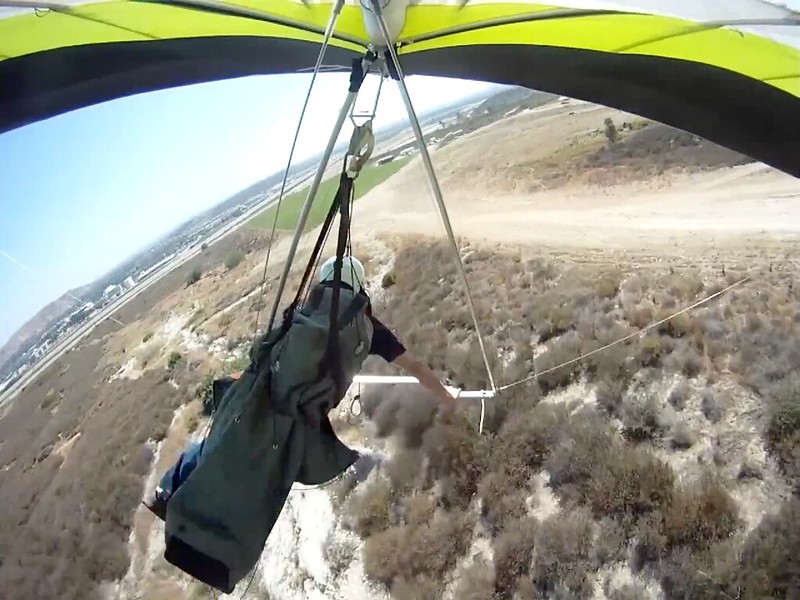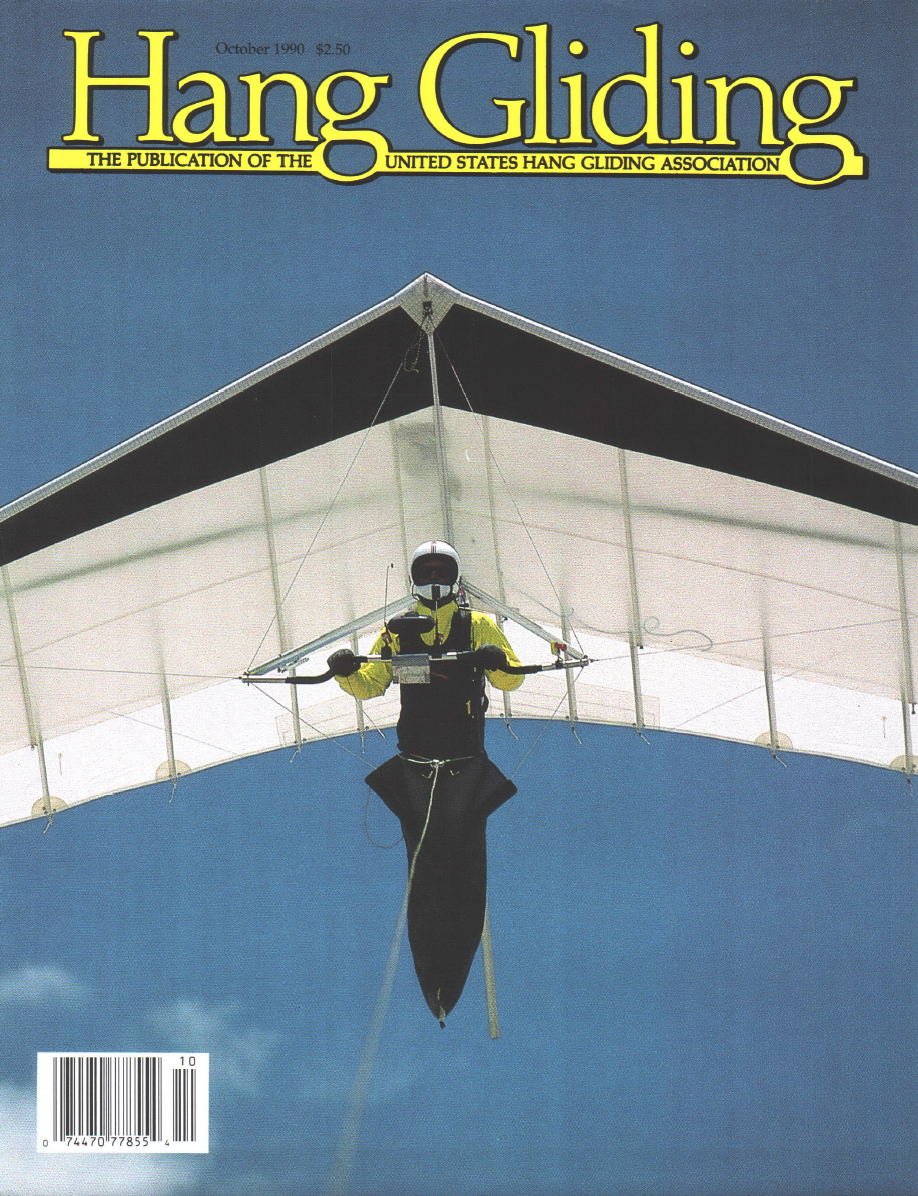http://www.hanggliding.org/viewtopic.php?t=29771
keel tow point
Tiberiu Szollosi - 2013/08/21 15:44:47 UTC
Have an aerotow question, what sort of knotting do you use to tie on to the keel?
Any pictures would be great

Mike Bilyk - 2013/08/21 21:00:01 UTC
Crestline
Instead of asking a forum a serious question, I would ask my instructor at the flying field.
Please don't hurt/kill yourself listening to a keyboard pilot.
- Shouldn't any AT rated pilot be qualified to properly/safely install a two point release assembly on a glider?
- Since all manufacturers are selling their gliders knowing full well that they'll be aerotowed shouldn't there be instructions and illustrations in all the owners' manuals for properly/safely installing two point release assemblies? (Shouldn't there also be specifications for weak links for all the models and recommendations for safe release assemblies?)
- Wouldn't there be one best knot for this purpose across the board? You don't find much in the way of different knots for the same application on sailboats. Why should it be any different on hang gliders?
- Are different instructors using/teaching different knots for this application?
- If different instructors are using/teaching different knots for this application isn't it rather fucking likely that some of them are wrong?
- Why isn't an issue this critical covered in the USHGA Aerotowing SOPs and Guidelines?
- If an issue this critical isn't covered in the USHGA Aerotowing SOPs and Guidelines then what where did you get your idiotic notion that some asshole certified by USHGA to sign off AT ratings has any better clue what he's doing with knots than your average jerk off the street?
- Shouldn't the glider manufacturer be the best authority on this issue? Some of them, for example, at least know what the function of the spreader...
Wills Wing
U2 145 and 160
Owner / Service Manual
U2 Set-Up Procedure
Verify that the main hang loop spreader bar is positioned just below the bottom surface.
...is supposed to be. And that's pretty fucking obviously...
1504
http://farm3.staticflickr.com/2831/9623912388_98cf582742_o.png

... a lot better than the flight parks, schools, dealers, instructors can manage.
Wills Wing was (is?) shipping glider's with a fucking BOWLINE being used to secure the VG system. You don't gotta be no rocket scientist to know...
http://www.hanggliding.org/viewtopic.php?t=22722
VG broke in Flight. Equipment failure
Wing Man - 2011/08/03 21:35:42 UTC
California
So I was up at Indian Valley this past weekend and had a shocking little experience. Five seconds after launch I felt what was like a brick hit my glider. Quickly, I thought of my hang lines but put that out of my head because I ALWAYS do a proper hang check and do the visual check myself.
So, the first corrective decision was to get the hell away from the mountain. So I go to pull on the VG... which just pulls and pulls with no resistance. Ah Ha! Problem found!
Now I am thinking of my preflight and I always check all the pulley connections and the ropes that connect the pulley box to the cross bar. This is what starts sticking out in my mind. That part is usually pulled tight and then rests on top of the screw that has a Phillip's head for that hinge that connects at the two cross bars. This has always drawn a concern to me because I imagine it causing wear and then eventually breaking through the rope. So every time I preflight I move it to the outside of the screw head. In doing so I am able to check the knot and make sure that it is secure.
When I got to the LZ I checked and it was this rope connection to the cross bars that came undone.
Talking with Wills Wing I was told that they have never heard of this coming undone before and most likely, since the glider has thirty hours on it, the knot was not fully seated and the tails that finish of the Bowline knot were not long enough and while the knot was seating it slipped past the tails allowing it to undo itself.
Craig Hassan - 2011/08/03 22:33:45 UTC
Didn't I read that bowlines are temporary knots and that you should not be used on that line? Thought it was a WW tb.
Wing Man - 2011/08/03 22:45:32 UTC
I spoke with Steve at WW and he told me they use a Bowline.
...what a really crappy idea that is. And Wills wing believes that a failure of that knot...
Wills Wing Technical Bulletin - TB20050620
Rope Maintenance and Inspection - Xbar Ball Center to VG Bock Connection
2005/06/20 - Issue Date
2007/05/15 - Rev Date
If this rope were to fail in flight, the crossbar would move forward unrestricted, until the sweep wire became tight - thus placing a shock load on the sweep wire. Although we have received no reports of in-flight failures of the sweep wire on any Wills Wing glider, we have seen anecdotal reports of sweep wire failure under shock load on other gliders, indicating that such a failure is possible.
...has the potential to kill you just as dead as it would in a climbing situation. And you don't gotta be no rocket scientist to know that climbers don't use Bowlines and the reason they don't use Bowlines.
So you tell me why Tiberiu's likely to get a worse answer to his question by throwing it out on a forum that any member of the public can read than by asking some Trisa, Rooney, Lauren grade shithead at some dump like Cloud 9, Ridgely, Quest.
- And, hell, according to everyone in The Industry it's not all that important to have a keel attachment point anyway...
http://www.ozreport.com/9.133
Lesson from an aerotow accident report
Steve Wendt - 2005/05/29
Holly for some reason chose to fly her Litesport, she has always towed it with proper releases and weak links and usually seeked advice from me when unsure of something.
This time she couldn't find her v-bridle top line with her weak link installed for her priimary keel release. She chose to tow anyway, and just go from the shoulders, which to my knowledge she had never done before, nor had she been trained to understand potential problems. This could have been done with a short clinic and if we thought it a possibility, been done under supervised conditions in the evening air.
After a reasonable bit of two point experience anyone can be easily trained to tow perfectly safely one point in a short clinic.
And if you should find yourself towing one point as a consequence of a two point bridle wrap...
http://groups.yahoo.com/group/skysailingtowing/message/549
Weaklinks/bridles; was: high wire act world news
Tracy Tillman - 2001/05/16 15:14:55 UTC
We (and many others) do not recommend using a second weaklink on the non-released end of the bridle. That weaklink is just as likely to break as the one on the other end. If the lower weak link breaks, the bridle could get caught in the towline ring, and pull the glider from the 'biner or keel, causing it to tuck. The other weaklink (on top) may not break prior to the tuck.
The weaklink should be on the released end of the bridle, and the bridle should release from the top. That way, if the bridle does get caught on the ring, it is pulling from the body, rather than from the glider, and the glider may still be controllable--in which case you can use your secondary release (or hook knife if that fails) to release.
...you don't even need the short clinic. You can fly along just fine with one hand while you're reaching for and trying to pry open your very very reliable bent pin release with no weak link limitation on the tension and...
http://www.hanggliding.org/viewtopic.php?t=21033
barrels release without any tension except weight of rope..
Bart Weghorst - 2011/02/25 19:06:26 UTC
I've had it once where the pin had bent inside the barrel from excessive tow force. My weaklink was still intact. The tug pilot's weaklink broke so I had the rope. I had to use two hands to get the pin out of the barrel.
No stress because I was high.
...when that doesn't work, pulling out your hook knife and hacking away at whatever you need to. So I really don't understand why it is...
http://www.hanggliding.org/viewtopic.php?t=17404
Aerotow barrel release - straight or curved pin?
Jim Rooney - 2010/05/30 10:54:17 UTC
Toma-y-to Toma-h-to
Back when Tad had his panties in a bunch, I decided to test things myself... it's easy to do... have a blast...
I took a single barrel release and hung it from the ceiling. I made a loop in a rope that allowed me to put my foot in the rope and be suspended an inch above the floor.
I opened the release.
Both open fine.
Curved pin was a little stiffer.
I filed it under Big Fing Deal.
I routinely use curved pin barrels to D-Bag.
...that you have your panties in a bunch anyway.


